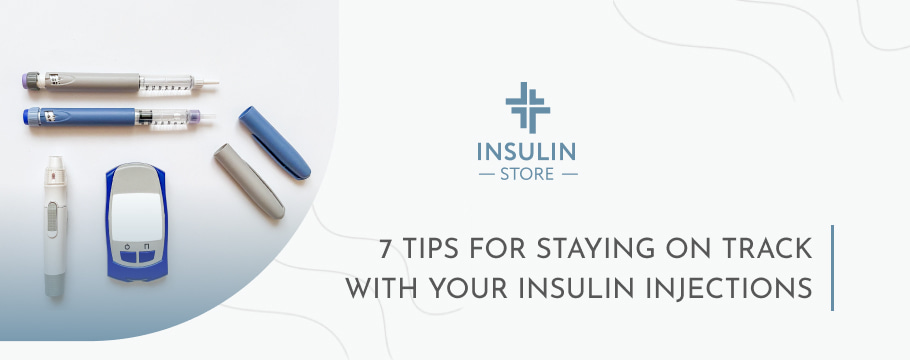
7 Tips for Staying on Track with Your Insulin Injections
By the time you’ve purchased your insulin online or in a drug store and received instructions on how to use it from your medical provider, your new injecting schedule might still be a bit tricky to follow. However, it’s still a very important part of diabetes treatment, as the right routine will improve not only hyperglycemia but blood pressure and your overall health as well.
It’s possible to adapt to your new lifestyle much easier by following 7 simple tips on tracking with insulin injections. With them, you’ll master keeping your blood sugar within a target range much faster.
Tip #1: Learn About Types of Diabetes to Understand Your Own Insulin Injection Routine
All 3 major types of diabetes make blood sugar levels stay abnormally high. However, each does it differently:
- Type 1 diabetes (T1D) occurs when a person’s pancreas doesn’t produce enough insulin on its own. This is why T1D patients must inject insulin on a daily basis;
- Type 2 diabetes (T2D) is a condition caused by insulin resistance. Unlike T1D patients, people with T2D have enough insulin produced by beta-cells, but the body’s sensitivity to this hormone is low. Aside from insulin, T2D patients can also use exenatide injections, diabetes pills, insulin sensitizers, and other medications;
- Gestational diabetes (GD) is caused by a woman’s placenta releasing a hormone that reduces the effects of insulin, resulting in insulin resistance. A treatment plan is similar to that for T2D but won’t necessarily be the same.
Learning more about your type of diabetes will help understand why do you take particular medications and how do they keep your sugars under control.
Tip #2: Consider Opting for Insulin Pumps or Insulin Pens
Just several decades ago, people with diabetes didn’t have today’s abundance of insulin delivery devices at their disposal. Even though the vial-and-syringe method still has its undeniable advantages, other options are superior in many ways:
- An insulin pump is a small device attached to the abdomen. It delivers insulin in steady mealtime medication doses at fixed time intervals, so it is unnecessary to carry syringes, needles, and fragile vials with you. Insulin pumps are mostly used by people with T1D, as they aren’t designed to deliver long-acting insulin injections;
- An insulin pen is a device with cartridges inside it. The cartridges are prefilled with either insulin or other antidiabetic agents. A pen allows setting a precise insulin dosage, provides easier insulin adjustment, and takes less space in your bag than vials and syringes. In reusable pens, once it’s out of medication, its owner can simply insert a new insulin cartridge and continue using the device.
Opting for more practical and easier-to-use devices will make diabetes management a more comfortable procedure for those who are just getting used to their injection routine.
Tip #3: Plan Your Budget
In the USA, the prices for antidiabetic medications are absurdly high. It’s not uncommon for patients who are short on budget to miss their insulin shots or split one dose in 2 or 3. Additionally, some people with diabetes reuse needles that must be disposed of after the first use.
Such measures are highly likely to lead to diabetes-related health problems. This is why you should always plan your budget so you can afford to give yourself an appropriate dose regularly, no matter what.
Tip #4: Consider Buying Cheaper Insulin
Today, it’s possible to buy insulin at a lower price:
- Over-the-counter insulin. The OTC insulin named “ReliOn” can be found in Walmart stores. This medication is produced in collaboration with insulin manufacturer Novo Nordisk and can be purchased at $25/vial;
- Canadian insulin. There is a loophole in the legislation that allows American residents to purchase insulin from licensed Canadian distributors. But keep in mind that you won’t be able to buy insulin online without a valid prescription from your medical provider.
Whatever choice sounds best to you, don’t forget to discuss its feasibility with a doctor first.
Tip #5: Test Your Blood Sugar Levels Regularly
Keeping track of your blood sugar is an important part of figuring out the best treatment routine. There are several ways to tell how much and how often your glucose level rises:
- HbA1c test. The results of the test show the average blood sugar level over the period of 2-3 months. HbA1c tells whether your routine keeps your blood glucose within a normal range or it fails to do so;
- Glucose tolerance test. A doctor will give you a special liquid and measure your blood sugar several hours after you drank it. This test shows your body’s insulin sensitivity;
- Fasting blood sugar test. This test is performed 8-12 hours after having a meal. Its results are not enough to diagnose diabetes, so they are interpreted in conjunction with other tests;
- Random blood sugar test. The test can be taken at any time and doesn’t require fasting before taking it. It shows how high your blood sugar is at a given moment.
You can check your blood sugar using the abovementioned methods. Ask your healthcare professional how often do you need to make blood sugar tests.
Tip #6: Set Reminders on Your Smartphone
Depending on the type of your diabetes, you may be taking long-acting insulin, rapid-acting, or short-acting insulin, sometimes in combination with an intermediate-acting one.
Each type of insulin must be taken at a different frequency, so they can avert extreme spikes in a person’s blood glucose level. Your doctor will give you comprehensive instructions on when and how to inject a particular dosage.
Still, just to be sure that you won’t accidentally miss the dose, set reminders on your smartphone, smartwatch, or use other means that will remind you to stick to the schedule.
Tip #7: Opt for Healthy Lifestyle to Maintain Steady Blood Sugar Level
For people with diabetes, it’s important to incorporate healthy habits into their daily routine:
- Exercise regularly. Staying fit brings positive effects on your blood circulation, thus improving blood pressure as well;
- Opt for consistent sleeping hours. Undersleeping causes stress, and stress causes blood sugar spikes;
- Don’t drink much alcohol and quit smoking, as it will elevate your glucose level instantly;
- Eating regular balanced meals. Your health care team will give you recommendations on which products won’t cause spikes and will provide your body with all the vitamins it needs.
Learn more about how to complement your insulin routine with healthy habits from your medical provider.
To Sum Up
To manage diabetes successfully, a person needs to be disciplined and follow their doctor’s instructions. Receiving insulin injections on time is of huge importance, as its uncontrolled use causes numerous dangerous diabetes complications, such as low blood sugar (or hypoglycemia).
Although following your diabetes routine can be challenging sometimes, there are several simple tips that will help you keep your glucose levels normal. Given the right treatment and responsible approach, it’s entirely possible for patients with diabetes to live a full and healthy life.
